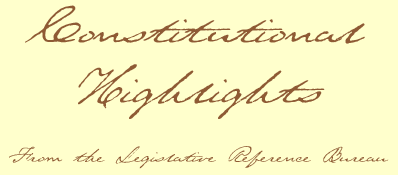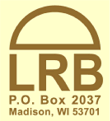
Wisconsin Legislative Reference Bureau
October 2004, Vol. IV, No. 4
Wisconsin Constitution
Article IX, Section 1
THE PUBLIC TRUST DOCTRINE
[T]he river Mississippi and the navigable waters leading into the Mississippi and St. Lawrence, and the carrying places between the same, shall be common highways and forever free, as well to the inhabitants of the state as to the citizens of the United States, without any tax, impost or duty therefor.
History and purpose of the section
The public trust doctrine is a body of common and statutory law that provides that the state holds title to navigable waters in trust for public purposes. The public trust doctrine has its roots in the English common law. Under English common law, the British Crown held title to the bed beneath tidal waters. This concept was incorporated into the Northwest Ordinance of 1787. The Northwest Ordinance states that “navigable waters leading into the Mississippi and St. Lawrence, and the carrying places between the same, shall be common highways and forever free….” When Wisconsin, which was a part of the Northwest Territories, became a state in 1848, this provision was included in article IX, section 1, of the Wisconsin Constitution.
The legislature, as the state’s representative, must not only take action to prevent endangerment of the trust but it must also take affirmative steps to protect the trust. Many of the common law protections embodied by the public trust doctrine are now codified under chapter 30 of the Wisconsin Statutes.
How courts currently interpret the section
The test used by courts to determine which waters are navigable and, thus, protected by the public trust doctrine has evolved over time. One of the earliest tests of navigability was the “saw log” test. Under that test, if a stream was capable of floating a “saw log” to market, the body of water was navigable. This test reflected Wisconsin’s interest in protecting commercial navigation.
With the passage of time, other uses of this state’s waters came to define navigability. As the public’s interest in the recreational uses of the state’s waters grew, the courts recognized those uses as integral to the determination of navigability. A waterway is now considered navigable if it is capable of floating any boat for recreational purposes. Furthermore, the waterway need not be continually navigable. It need be navigable only on a regularly recurring basis, such as during spring runoff periods. The trust also applies to artificial navigable waters that are “directly and inseparably connected with natural, navigable waters.” Klingeisen v. DNR, 163 Wis. 2d 921, 929 (Ct. App. 1991).
The state has traditionally been the owner of lake beds up to the ordinary high-water mark. The ordinary high-water mark is the point on the bank or shore where the water, by its presence, wave action or flow, leaves a distinct mark on the bank or shore. Accordingly, the trust doctrine encompasses not only navigable waters, but also the beds underlying those waters with the exception of streambeds. As discussed below, riparian owners hold title to stream beds to the center of the stream.
As the test for navigability has evolved over time, so has the concept of what constitutes a public purpose. Initially, public rights were limited to navigation and fishing. In Diana Shooting Club v. Husting, 156 Wis. 261, 271 (1914), the Wisconsin Supreme Court expanded the concept of public rights in navigable waters by holding that navigable waters “should be free to all for commerce, for travel, for recreation, and also for hunting and fishing, which are now mainly certain forms of recreation.” Public rights now include not only recreation, but also natural beauty, the prevention of pollution, the protection of water quality, and the protection of shorelands and wetlands.
While the state holds navigable waters in trust for all its citizens, the legislature may authorize limited encroachments upon the beds of such waters where the public interest will be served. State v. Public Service Comm., 275 Wis. 112, 117 (1957). By statute, the legislature has created a system of permitting procedures that ensure that projects affecting navigable waters do not violate the public trust doctrine as it has developed under common law. The legislature has delegated the authority for administering this trust to the Department of Natural Resources.
Many of the cases involving the public trust doctrine address the tension between public rights in navigable waters and the rights of riparian owners. Riparian owners are persons who own land that abuts a waterway. Under Wisconsin law, the state owns the beds of all navigable waters with the exception of navigable streams. Riparian owners own the beds underlying navigable streams up to the center of the stream. Riparian rights include the use of the shoreline, the reasonable use of the water, and the right to build piers for navigation. When conflicts arise between riparian rights and the public rights of nonriparians, riparian rights are secondary to the public interest. See John Quick, Comment, The Public Trust Doctrine in Wisconsin, 1 Wisconsin Environmental. Law Journal 105, 116 (1994). In order to ensure that both public rights and riparian rights are protected, the legislature has delegated to the Department of Natural Resources the authority to issue permits for the placement of various structures in navigable waters.
Notwithstanding the fact that the public trust doctrine protects the public’s rights in navigable waters, it does not require public access to those waters. The Wisconsin Supreme Court, in the case of Doemel v. Jantz, 180 Wis. 225, 234 (1923), held that a riparian owner has the “exclusive privileges of the shore for purposes of access to his land and water.” In order to ensure that the public has access to navigable waters, the state and many municipalities have acquired land that creates public access areas to these navigable waters.
The legislature has a limited ability to convey lake bed lands because those lands are part of the state’s trust property. The legislature may make grants of lake beds but only if the lake bed land is used for public purposes. Further, the grant does not operate to transfer the legal title from the state. See Melissa Scanlan, Comment, The Evolution of the Public Trust Doctrine and the Degradation of Trust Resources: Courts, Trustees and Political Power in Wisconsin, 27 Ecology Law Quarterly 135, 149 (2004).
The legislature may delegate the administration of the public trust in navigable waters to local governments, but only under certain circumstances. The legislature may not delegate administration of the trust for purely local concerns if such delegation does not promote the statewide public interest in trust resources. The legislature may delegate power over navigable waters only if it retains oversight over the delegee, the delegation advances the paramount interests of the public, and the delegation establishes clear limits and definite standards.
By statute, the legislature has extended its public trust responsibilities to include the protection of shorelands and wetland areas adjacent to navigable waters. In the case of Just v. Marinette County, 56 Wis. 2d 7 (1972), in which the Wisconsin Supreme Court held that Marinette County’s shoreland zoning ordinance was constitutional, the court recognized that “lands adjacent or near navigable waters exist in a special relationship to the state.”
Strategies for reconciling legislation with the section
For all of the reasons discussed above, a legislative proposal affecting navigable waters must comport with the public trust doctrine. The first consideration that a legislator should make is whether a proposal will affect waters that are navigable. Generally, if a proposal would affect nonnavigable waters, the public trust doctrine is not likely to apply.
If a proposal does affect navigable waters, the legislator should consider the following issues:
Grants of trust property
The legislature may make grants of public trust property only if the property is used for public purposes. For example, the legislature may make a grant to a city to develop a lakeside park. Such a grant does not, however, transfer the legal title of the property from the state. Any grant of property for purely private purposes is void. The Wisconsin Supreme Court has developed a five-factor analysis to determine if a lake bed grant is consistent with the public trust doctrine. Under this analysis, the court considers all of the following: 1) whether public bodies will control the use of the area; 2) whether the area will be devoted to public purposes and open to the public; 3) whether the diminution of lake area will be very small when compared with the whole waterway; 4) whether any one of the public uses of the lake as a lake will be destroyed or greatly impaired; and 5) whether the impairment of the public’s right to use the lake for recreation is negligible when compared with the greater convenience afforded to the public from the grant of the lake bed property. A proposal to make a lake bed grant is more likely to be upheld by a court if it satisfies all of these requirements.
Delegation
If a legislator proposes to delegate authority over navigable waters to a local unit of government, the proposal must include clear limits and definite standards for the delegee to follow. For example, a proposal giving local governments authority to regulate boating practices should specify at a minimum that the regulations must be designed to promote public safety. Such a delegation of authority is more likely to be upheld if the delegation contains additional limits and standards.
Scope of proposal
The legislature has allowed certain deposits or structures to be placed in navigable waters provided that they do not materially obstruct navigation and are not detrimental to the public interest. The Wisconsin Supreme Court has held that it will look at the cumulative effect of those deposits or structures to determine if they materially obstruct navigation or are detrimental to the public interest. That is, even if the placement of a relatively small amount of fill by a riparian owner into a waterway may not materially obstruct navigation, the court may consider the effect such placement would have on the waterway if undertaken by many riparian owners. Consequently, a proposal authorizing the placement of any deposit or structure in a waterway should be as narrowly drawn as possible to ensure that the cumulative effect of such placement does not violate the public trust doctrine.
Avoid private and local issues
The Wisconsin Constitution prohibits private and local laws that embrace more than one subject and requires that a bill’s title express the subject of any private or local provision in the bill. Because the biennial budget bill typically covers many subjects and has only a general title, it should not include a private or local provision. Consequently, a proposal that affects a particular body of water or that affects a particular person’s use or enjoyment of that body of water should not be included in the biennial budget bill. Rather, the proposal should be advanced as a separate piece of legislation to avoid a possible constitutional challenge. See, Peter Grant and Marc Shovers, Title of Private Bills, Constitutional Highlights From the Legislative Reference Bureau, Vol. 1 (2001).
Prepared by Robin Kite, Senior Legislative Attorney
One East Main Street
Madison, WI 53701-2037
(608) 266-3561
www.legis.wisconsin.gov/lrb

